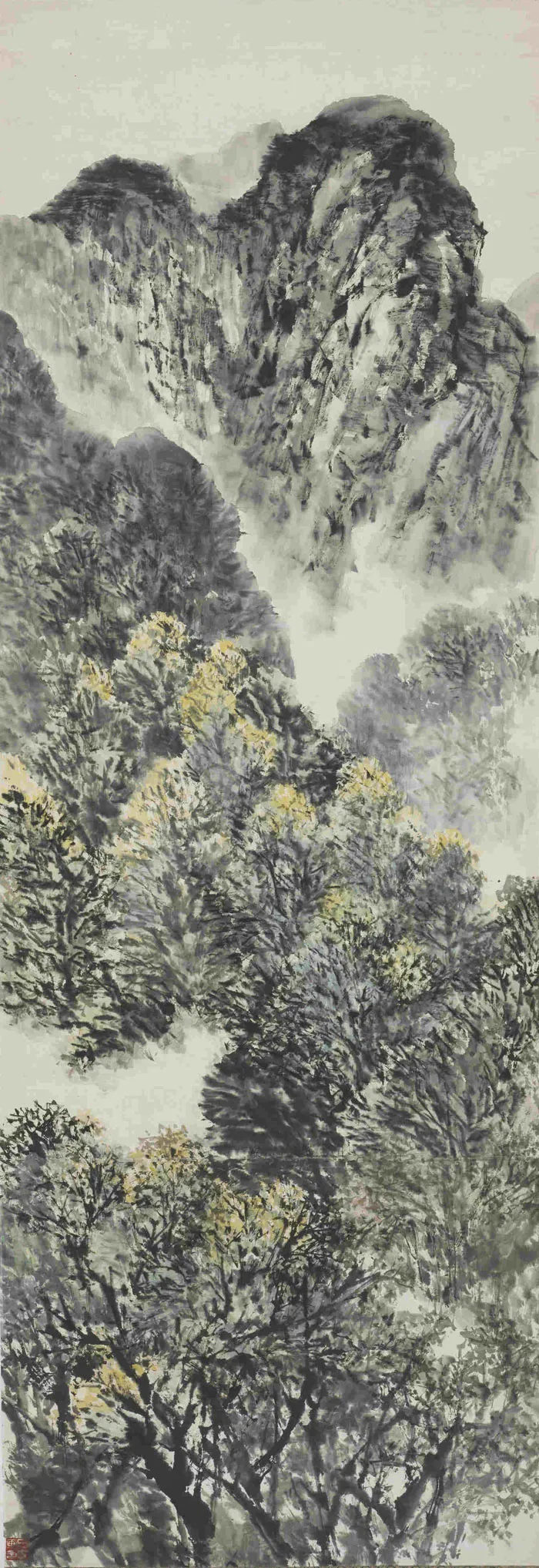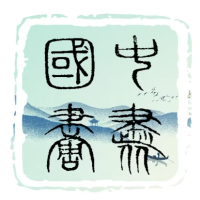石鲁,讳亚珩,蜀地仁寿文公乡人,祖籍江西景德镇。生于己未年十一月,殁于壬戌年七月。中国当代书画大家,精于山水、花鸟。
Shi Lu, courtesy name Ya Heng, was a native of Wengong Township, Renshou, Sichuan, with ancestral roots in Jingdezhen, Jiangxi. He was born in the eleventh month of the Jiwei year and passed away in the seventh month of the Renxu year. A prominent contemporary Chinese painter, he excelled in landscapes and bird-and-flower paintings.
石鲁出身富贵之家,冯氏祖籍景德镇,高祖避税迁川,贩药售棉,积巨资,终安家仁寿文公镇。曾祖继其业,于松林湾垦田筑屋,成仁寿第一大粮户。家族仿《红楼梦》大观园之制,建冯家庄园,藏书十万余册。石鲁幼承富贵,亦受封建家规之约;观家道兴衰,得古文化熏陶。尤受其兄冯建吴之影响。年十五,石鲁离其家,赴二兄执教之东方美专。
Shi Lu was born into a wealthy family. The Feng family, originally from Jingdezhen, Jiangxi, relocated to Sichuan to avoid taxes, engaging in the trade of medicine and cotton to amass considerable wealth, eventually settling in Wengong Township, Renshou. His great-grandfather continued the family business, developing land and building homes in Songlin Bay, becoming the largest grain landlord in Renshou. The family estate, modeled after the Grand View Garden in "Dream of the Red Chamber," housed over 100,000 books. Shi Lu enjoyed material affluence in his youth but was also bound by feudal family rules; he witnessed the rise and fall of his family and was steeped inical culture. Particularly influenced by his brother Feng Jianwu, Shi Lu left home at fifteen to attend the Oriental Art School where his brother taught.

石鲁之名,如天命所定。其人具石涛之个性,鲁迅之批判。画风犷率硬朗,有“黑、重、怪、野”之称。虽有争议,或称“东方梵高”,或斥其野怪,然石鲁创新,实为中国画坛新风。
The name Shi Lu seemed destined by fate. He embodied the assertiveness of Shi Tao and the critical spirit of Lu Xun. His painting style was rugged and bold, described as "black, heavy, strange, wild." Though controversial, with some calling him the "Eastern Van Gogh" and others criticizing his wildness, Shi Lu's innovation undeniably brought a fresh breeze to the Chinese art scene.
石鲁生平,常与二十世纪美术之大议题相缠,艺术与革命、启蒙;艺术与大地、人民、生活;传统与当代;人文理想与革命信仰;人格与艺术。其身集二十世纪艺术之要素:启蒙、革命、传统、守成、反叛、人民、生活、理想、自由,彼此交织,成其焦虑与矛盾之灵魂。现代以来,焦虑与矛盾为大师特征,石鲁亦然。因焦虑矛盾,石鲁思考才华喷涌而出,书写天才之史。
Shi Lu's life intertwined with major art themes of the 20th century: art and revolution, enlightenment; art and land, people, life; tradition and contemporary; humanistic ideals and revolutionary beliefs; personality and art. He embodied key elements of 20th-century art: enlightenment, revolution, tradition, conservation, rebellion, people, life, ideals, and freedom. These elements interwove, creating a soul of anxiety and contradiction. Since modernism, anxiety and contradiction have characterized master artists, and Shi Lu was no exception. Through this tension, his thoughts and talents erupted, writing the history of a genius.
石鲁钟情陕北黄土高原风情与民生,倡“一手伸传统,一手探生活”,为时陕西美术创作指南。创北方首派——长安画派。长安画派以西北自然、人情为载,融革命浪漫与阳刚美学,开西北绘画题材,居时代前列。
Shi Lu had a deep affection for the customs and people of the Loess Plateau in northern Shaanxi, advocating "one hand reaching out to tradition, one hand reaching out to life," which became the guiding principle for Shaanxi art creation. He founded the first northern school of painting, the Chang'an School. This school used the natural scenery and human stories of the northwest as its foundation, combining revolutionary romanticism and robust aesthetics. It pioneered northwest painting themes and stood at the forefront of the era.
石鲁,思考与激情并存,山水、人物、花鸟、书法、印章、诗词、文学、艺术理论,皆有独到之处,彰显时代感与前瞻性。早期画风写实,用笔坚实谨严,常绘革命题材;后期奇崛劲健,尤爱华山荷花,笔力纵恣雄豪。
Shi Lu, a figure of both contemplation and passion, excelled in landscapes, figures, flowers and birds, calligraphy, seals, poetry, literature, and art theory, all showcasing a distinct individuality imbued with a sense of the times and foresight. His early style was realistic, with firm and meticulous strokes, often depicting revolutionary themes. In his later years, his style became more vigorous and bold, particularly favoring Mount Hua and lotuses, with exuberant and heroic brushwork.
自庚辰岁始,十年间,石鲁创作众多艺术作品,反映抗日战争与新民主主义革命,皆饱含革命生活情感与审美趣味。新中国始立,石鲁秉持“从生活入手”宗旨,深入青海藏区、宝成铁路、兰新铁路工地,祁连山、乌鞘岭、陕南与陕北,与建设者同吃住,绘劳动人民形象,以画笔彰新时代风貌。五十年代中后期,反思早期水墨技法中西洋画倾向及美学情节化,潜心研究古典美学,临摹历代名家法书与绘画,汲取传统文化养分,丰富艺术创作。
Starting from the year of Gengchen (1940), over the course of ten years, Shi Lu created numerous works of art reflecting the War of Resistance against Japan and the New Democratic Revolution, all deeply imbued with the emotions and aesthetic tastes shaped by revolutionary life. After the founding of the People's Republic of China, Shi Lu upheld the principle of "starting from life," immersing himself in the Tibetan areas of Qinghai, the construction sites of the Baoji-Chengdu and Lanzhou-Xinjiang railways, Qilian Mountains, Wushaoling, southern and northern Shaanxi. He lived and ate with the builders, creating portraits of the working people, using his brush to depict and praise the new era. In the late 1950s, he began to reflect on the Western tendencies in his early ink painting techniques and the narrative inclinations in his aesthetics, delving intoical Chinese aesthetics, copying the works of renowned ancient calligraphers and painters, and enriching his artistic creations by drawing nourishment from traditional culture.
庚戌岁后,石鲁艺术转向精神,从抒情浪漫转向孤愤沉雄,从现实诗意描写转向形而上自然大道。其笔法劲健、险峻、跳跃,如金石崩裂,尽显后期大写意神髓。通过诗、书、画、印结合之艺术语言,石鲁实现主体意识之觉醒。七十年代,石鲁绘画题材多为华山、黄河、花卉、动物,绘画形式则诗书画印结合,展现传统文人画形态。
After the year of Gengxu (1970), Shi Lu's art shifted towards spirituality, from lyrical and bright romanticism to solitary and robust profundity, from poetic depictions of reality to metaphysical expressions of natural Tao. His vigorous, precipitous, and leaping brushstrokes, akin to the cracking of stone, embody the essence of his later grand freehand style. Through the integration of poetry, calligraphy, painting, and seals, Shi Lu achieved a profound awakening of his subjective consciousness. In the 1970s, his subjects mostly included Mount Hua, the Yellow River, flowers, and animals, with his artistic forms combining poetry, calligraphy, painting, and seals, showcasing the traditional literati painting style.
石鲁主张山水“当作人来画”,甚至谓“山水画即人物画”。山水画不仅自然景色之呈现,更是人之精神象征。石鲁画源于生活,不“照猫画虎”,从现实出发,改造形式,革新技法,重视独创与构思之经营,抓住生活中直观印象,形成现实主义特色。
Shi Lu advocated for painting landscapes "as if they were people," even asserting that "landscape painting is figure painting." He believed that if landscape painting merely presented scenery objectively, the painter would be absent. Landscape painting, he argued, should also embody grandeur, symbolizing human spirit. Thus, landscape painting is humanized. Shi Lu’s art drew from life, but never merely copied it. He started from reality to transform forms and innovate techniques, valuing originality and painstaking conceptualization, while capturing the direct impressions from life, forming a distinct realist characteristic in his art.
















石鲁写生不拘一格,铅笔、钢笔、毛笔皆用。丁酉岁以前,速写真实自然,手法细腻;后用“以神取形”理论指导实践,面对写生对象,从提炼、变体到构图,一次而成,技法千变万化,因意选材施法,无一定法。
Shi Lu’s approach to sketching was eclectic, utilizing pencils, pens, and brushes. Before the year of Dingyou (1957), his sketches were realistic and natural, with delicate techniques. Afterwards, guided by the theory of "capturing the spirit to shape the form," he refined, altered, and composed his sketches in one go. His techniques varied greatly, ranging from densely lined copperplate etching to the rugged simplicity of Qin and Han sculptures, from intricate floral outlines to slightly decorative deformed figures, all executed according to the intended artistic effect without a fixed method.
绘画用笔用墨,石鲁作品纵横交错,笔笔见骨,性主刚,突显金石味,稚拙而灵动,富笔情墨趣。人物画以人为中心,现代“天人合一”观,表现人之壮美精神品格,作品中少或无自然景色陪衬,但人之精神力量与自然环境、历史风云统一,通过画外之画想象得以实现,形成强化之美。
In his brush and ink usage, Shi Lu’s works were marked by bold and uninhibited strokes, each stroke revealing its bone, highlighting a taste of stone carving, both naive and lively, full of brush and ink charm. His figure paintings centered on the human element, promoting a modern concept of "harmony between heaven and man," wherein the grandeur of the human spirit and the natural environment, historical changes, were achieved through imaginative extrapolation beyond the painting itself, forming a reinforced beauty of spiritual power.
花鸟画以主观意识高扬、内在冲动爆发、金石力度强化、笔路狂放诡奇为特征,用笔多作三角形,更概况、更抽象,区别于二十世纪六十年代花鸟画之风神,成为石鲁后期狂放型艺术组成部分。花卉白描与变形人物,展示对现实生活再现与升华。
Shi Lu’s flower-and-bird paintings were characterized by a high degree of subjective consciousness, explosive internal impulse, reinforced stone carving strength, and wildly peculiar brushstrokes, often using triangular brushstrokes, more abstract and generalizing. Distinct from the flower-and-bird painting style of the 1960s, they became part of his later unrestrained artistic expression. His floral outlines and deformed figures displayed the recreation and sublimation of reality.
《转战陕北》创作中,石鲁以拖泥带水、水墨交融之技法,笔力强劲、浑厚、生辣,创造性运用直、硬、棱角外露及墨色相融语言,塑造高原断层黄土质地感。圆主柔,方主刚,两者结合,塑造“大巧若拙”境地。《转战陕北》中,写实再现陕北黄土高原,倾注革命赤诚,独特感受与革命理想真实表述,成就其在中国画美术史重要地位。
In the creation of "Advance to Northern Shaanxi," Shi Lu employed a unique technique of dragging and blending ink, creating powerful, thick, and raw strokes, creatively using straight, hard, and angular lines blended with ink washes to depict the loess texture of the plateau. Believing in combining softness with hardness, he portrayed an atmosphere of grandeur and simplicity. In "Advance to Northern Shaanxi," Shi Lu not only realistically depicted the loess plateau of northern Shaanxi but also infused the painting with his revolutionary fervor, unique sentiments, and sincere depiction of revolutionary ideals, securing its significant place in the history of Chinese painting.
石鲁之人生与艺术,堪称传奇。此词用于他,虽显单薄,亦不失为贴切之选。石鲁善将互不相干、甚至矛盾之物圆融一体,如家国宏大叙事与个人内心自语,革命艺术家与知识分子艺术家、现实主义写实性与古典文人画写意性、生活与传统等。此种张力所形成精神与语言疆域,正是石鲁创作空间,推动其艺术达至史诗般境界。
Shi Lu’s life and art can be aptly described as legendary. This term, though grand, is fitting for Shi Lu. He adeptly fused seemingly unrelated or even contradictory elements into a harmonious whole, such as national narrative with personal introspection, revolutionary artist with intellectual artist, realist depiction with literati freehand, and life with tradition. The vast spiritual and linguistic territory formed by this tension was the creative space from which Shi Lu's art emerged, propelling his work to epic heights.
石鲁历经二十世纪复杂精神活动与心路历程,从救亡、革命、启蒙、反叛,至乌托邦主义,从疯癫、狂悖、妄想到超越。比之传统文人狂傲,石鲁淬过革命之火,有绝高风骨。唯其如此,方能于历史幽暗处闪烁个性光芒。石鲁绘画、书法、画论留于当代者,可称为艺术之物;其人格泽备当代者,乃高逸品质。石鲁,以其激情与思考之笔触,书写辉煌篇章,留无数艺术珍宝,成传奇人生。
Shi Lu experienced the most complex spiritual activities and journeys of the 20th century: from salvation, revolution, enlightenment, rebellion, to utopianism, from madness, defiance, delusion to transcendence. Compared to the arrogance of traditional literati, Shi Lu’s solitary pride and transcendence were forged in the fire of revolution, exhibiting supreme integrity. This enabled his individuality to shine brightly in the darkness of history. His painting, calligraphy, and art theory bequeathed to contemporary times something that can be called art; his character bequeathed a model that can be called "a man in capital letters."Shi Lu, with his passionate and contemplative brushstrokes, wrote magnificent chapters, leaving countless artistic treasures, achieving a legendary life.
责任编辑:苗君
